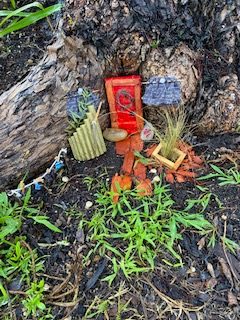
| Forget baseball. It’s official now. America’s favorite pastime is walking. With COVID-19 lockdowns in full force, walking has become a liberator from the confines of home turned office turned school. Going for a walk is now a standard diversion from a world that’s both wildly uncertain and tediously routine. A stroll around the block isn’t as exciting as a trip to Kuala Lumpur. But there are discoveries on every outing. While on a walk recently, a friend of mine spied a series of “fairy gardens” that children in his neighborhood made at the base of trees. Tiny doors set against the tree trunks presumably opened into a magical land. (See pictures below.) My friend took this as a hopeful sign. Maybe the children know that somewhere out there is a better world, he mused. In my neighborhood, it’s become prime-time entertainment to look out my kitchen window and see pedestrians boldly walking down the middle of empty streets. A hot pink mask counts for fashion on the catwalk of LA sidewalks now. I can’t tell if the dogs I see trotting alongside their owners on their multiple daily jaunts are gleeful or exhausted. Long before COVID-19, we knew walking was good for us and that sitting was the new smoking. Fitbits and iWatches prodded us to get off the couch. But it took a pandemic to motivate us. It’s one habit that I hope stays with us whenever our world returns to normal. Standing upright and propelling ourselves forward on two legs is uniquely human. Walking is so beneficial to us in so many ways that if it were a pill, we’d pop it like an M&M. Walking is one of the most studied forms of exercise, and research shows that it can lower body mass, cholesterol, and blood pressure. It improves memory and cognitive function. Studies also show that walking can boost our moods and reduce depression. It even spurs creativity. Have you ever wondered why your best ideas strike you while strolling? Researchers at Stanford asked people to come up with alternative uses for everyday objects and found that people who walked before given the task came up with twice as many ideas as those who stayed put. A walking brain is a more active brain and is more capable of ideation and creation, according to Shane O’Mara, a Trinity College professor and author of the book “In Praise of Walking: A New Science of Exploration.” She recommends that before working on any thorny problem, you write down a few questions about your dilemma or project and then take a hike. Often, the issue solves itself before you return home. Walking is the low-hanging fruit of physical activity. And if you’re getting less than 5,000 steps a day, you’re considered “clinically sedentary.” Physical therapist and mobility guru Kelly Starrett says that our ancestors walked while carrying heavy things. He sometimes schleps a 50-pound sandbag when he walks just to up the ante. But, of course, it’s enough to put one foot in front of the other. You can do so mindfully by paying attention to the swing of your legs and the step of your feet. Bringing awareness to the body and using walking as a meditation is a sure-fire way to quiet a mind whirling with worry. What’s more, you’ll never know what you’ll discover once you’re out the door. I like to walk at dusk when the street lamps begin to illuminate the peace that descends over my neighborhood at night. If I can get a walk during the day, I’ll do that, too. The other morning, I felt a bit deflated, realizing that we’re in for a long COVID-19 haul. To boost my spirits, I went on a walk and came across a poem – yes, a poem – that was heaven-sent. Typed out on a sign in a neighbor’s yard were the lines below from poet Edna St. Vincent Millay. Maybe you’ll discover something just as inspiring on your next walk. “From the apprehensive present, from a future packed With unknown dangers, monstrous, terrible and new- Let us turn for comfort to this simple fact: We have been in trouble before… and we came through.” –Edna St. Vincent Millay |